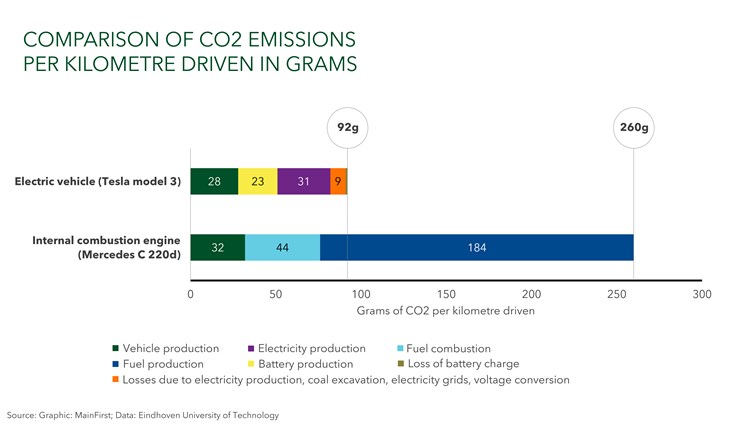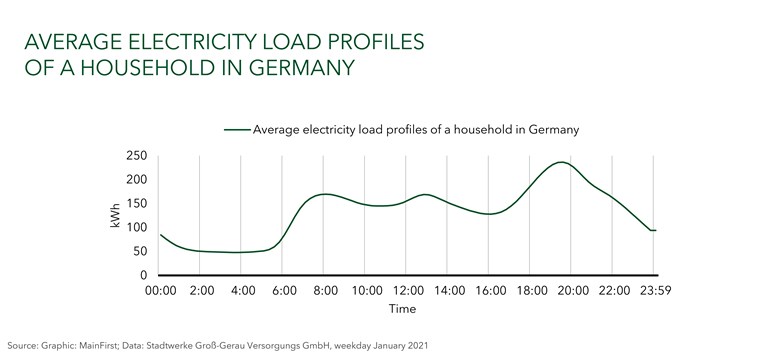For a long time, the rumour circulated that electric vehicles were bad for the environment and only a deceptive package. This is quite simply wrong, because often completely incorrect figures were used for calculations and the results of the subsequent studies were disseminated via the media.
Pub clichés such as "The electric car does not result in any CO2 savings. Battery production is so energy-intensive that on balance the carbon footprint is worse. In addition, the power grid would collapse if a large number of people were charging at the same time and one should wait until more electricity is available from renewable energy sources" along with other opinions on the subject of electric vehicles have become widespread in recent years. This is partly due to the fact that in 2019, the ADAC (the German Automobile Association), with its over 21 million members, reinforced the perception of alleged electric vehicle haters with headlines such as "Electric cars travelling with heavy climate baggage " (1) and further fuelled the negative sentiment towards the new technology. Manager Magazin also wrote in 2019 "Overall CO2 footprint worsens" (2) while in the same year, far more scientific sources such as the ifo Institute (3) portrayed the electric vehicle as a polluter with higher emissions than the good old combustion engine. With the headline "Much more CO2 than thought" (4), the daily newspaper "Die Welt" also does not paint a favourable picture of electric vehicles. But these assumptions are probably wrong.
Methodological errors in the emissions calculation
All these authors refer to a highly controversial study from 2017, which reports that battery production produces vast quantities of emissions, namely between 150 kg and 200 kg of CO2 per kWh. However, the authors of this study (5), which was commissioned by the Swedish Environmental Research Institute IVL and later became known as the Sweden Study, never collected their own emissions data for battery production. Instead, data from other, older studies was combined with sometimes extremely outdated values from smaller battery laboratories. And this is precisely where the problem lies. It is true that the production of an electric vehicle produces slightly more CO2 than that of a combustion engine. During production, the batteries have to be treated in large drying ovens for 30 to 40 hours. However, it makes a significant difference whether 1,000 or 100,000 cells are loaded into an oven at the same time. The energy input per cell drops dramatically as the number of units increases. In recent years, it has also been possible to significantly reduce production waste and the production technology has been further improved by a number of factors, such as the conservation of heat during the drying process. Economies of scale are therefore the decisive factor. Due to the outdated data, the study was immediately criticised by scientific sources (6-7). However, this did not stop the aforementioned sources, along with other electric vehicle opponents, from continuing to rely on the misleading data. In 2019, the authors of the original Sweden Study responded to the criticism with an updated version and more than halved their CO2 estimate (8).
A fair CO2 comparison is only possible if all factors are taken into account
Each statistic is only as good as the data on which it is based. In order to measure carbon footprint in a meaningful way, as many influencing factors as possible should be taken into account. When evaluating its experiment, a renowned research team from Eindhoven University of Technology analysed as many influencing factors as possible and came to a definitive conclusion (9). After the start of the experiment in 2020, two test cars, a diesel car and an electric vehicle, will each drive 180,000 kilometres over a 12-year lifespan. In the first years of use, a car is usually driven a little more; with increasing age, the annual mileage decreases. On average, both vehicles will drive 15,000 kilometres per year. The fuel consumption of the diesel car remains constant during its service life. In terms of charging electricity, it can be assumed that the European electricity supply will continue to shift towards renewable energies in the coming years. The proportion of coal-fired electricity in the EU alone has already halved since 2015 and was only 13 percent in 2020. Recent scientific studies have also shown that even with battery production in China, which still has a relatively high proportion of coal-fired electricity at over 50 percent, the advantages of electric vehicles are significant enough to improve the overall carbon footprint. Surprisingly, the average CO2 advantage of the electric vehicle over its entire life cycle is 64 percent. The additional emissions from battery production have already been amortised after about 30,000 kilometres. The following graph illustrates the CO2 emissions per kilometre driven. These are generated from the emissions of vehicle and battery production, as well as from fuel consumption and electricity demand.
But why are the conclusions of this analysis so different from many previous depictions? In particular, a number of German studies in recent years have led to an emerging scepticism towards e-mobility due to environmental concerns. Errors were often made in the selection of the analysis data and a look towards the future, to a world with significantly lower emissions in electricity production, was also frequently not carried out. In the following, is a list of the most important aspects that are imperative for calculations when carrying out a fair comparison.
Emissions from battery production
Many of the studies currently available use exaggerated assumptions regarding energy demand in the production of lithium-ion batteries, as outdated emission data is used. Economies of scale are the decisive factor here. In 2020, over 3 million electric vehicles were built. This represents a sevenfold increase compared to 2015 (10). In the coming years, we expect this to increase more rapidly. The latest studies assume CO2 emissions of between 40 and 100 kg/kWh for batteries produced today (10). China is at the upper end of this range due to its high proportion of coal-fired power, and Europe is at the lower end due to its higher proportion of renewable energy. In this comparison, an average CO2 value of 75 kg/kWh was calculated. According to its own information, Tesla's Gigafactory in Nevada in the US, already produces batteries in a CO2-neutral manner, as the electricity is obtained exclusively from renewable energies (11).
Battery lifespan
The lifespan of batteries is underestimated by some studies, for example by the ifo Institute (3). They assume a lifespan of 150,000 kilometres, whereas a diesel car is expected to last 300,000 kilometres. The reality is different, and contrary to the expectations of consumers who are concerned that an electric vehicle battery could wear out as quickly as a laptop or mobile phone battery, the latest findings suggest that modern batteries can be driven for more than 500,000 kilometres. The advances in temperature and charging management are impressive. In 2019, Tesla published the actual remaining battery capacities of thousands of its customers who voluntarily reported them, depending on the mileage they drove.
After more than 320,000 kilometres driven (approximately 200,000 miles), the majority of the vehicle fleet still had a battery capacity of about 90 percent (12).
In addition, the scientific journal "Journal of the Electrochemical Society" states that the NMC cells already in use today are capable of a driving performance of over 1.5 million kilometres (13). Although the tests for this were carried out under laboratory conditions, the science shows that the further development of lithium-ion technology is still in its infancy and has a lot of potential for improvement. Internal combustion engines, on the other hand, have reached the maturity phase of their development. It is questionable whether the lifespan of combustion engines - with an increasing number of technical parts being installed, such as turbochargers, cylinder deactivation or hybrid technology - will increase significantly. We take a conservative approach in this comparison and assume a lifespan of 250,000 kilometres for both internal combustion engines and electric vehicles. It should also be noted that this comparison focuses exclusively on CO2 emissions and climate impact. A combination with aspects such as other emissions, resource consumption, working conditions or noise pollution cannot form part of a serious consideration of CO2 and climate impact.
Development of electricity production and consideration of pre-emissions from fossil fuels
Many studies assume that an electric vehicle will be charged for the entire life cycle of the car with the same electricity that it consumes in the first year. Such assumptions are unrealistic. CO2 emissions from electricity production in Europe have fallen by 32 percent since 2012 (9). Given the Paris Climate Agreement and a generation of politicians that is increasingly focused on the environment, it can be assumed that the reduction of emissions from electricity generation will continue to take place and may even accelerate. While electric vehicles will benefit from this development over their life cycle, the fuel consumption of an internal combustion vehicle produced today is fixed. Synthetic fuels should not make a significant savings contribution. So much energy is lost by converting electricity into synthetic fuels and then converting it back into kinetic energy through combustion that it would be preferable to charge an electric vehicle directly, as this would have a much higher efficiency factor. However, both the pre-emissions from electricity production and those from diesel or petrol should be taken into account. How much electricity is lost within the electricity grids or during the charging process? How much energy is required to produce the gas that generates electricity in a gas-fired power plant? How much electricity does the power plant itself need to operate? What level of emissions is produced by transporting fuel across the ocean to the petrol station, or by the fuel production itself? The construction of an oil platform produces emissions, just as the construction of a wind farm produces CO2. Burning one litre of petrol produces about 2,200 grams of CO2. The production itself, however, produces another 940 grams. The consideration of these so-called pre-emissions is vital for a fair comparison of the two types of propulsion.
Charge loss is around 5 percent over 30 days
An electric vehicle's lithium-ion battery loses about 5 percent of its battery charge in 30 days. An average car driver drives about 1,200 kilometres during this period and therefore charges the battery three to four times. Consequently, the loss of charge only has a negligible effect on the CO2 footprint.
Will the power grids collapse?
Today's electricity grids are designed to be able to handle peak loads over the course of the day. There is frequent criticism that the widespread use of electric vehicles would overload the grids if they were charged at the same time. As far as the adoption of e-mobility by the general population is concerned, we are currently still in a test phase. However, it has been shown that the typical electric vehicle driver only uses about 10 percent of their available battery capacity per day and that for more than 95 percent of their day, does not use the car. Assuming that some of the electric vehicle drivers have the opportunity to charge their vehicle at home or at work, this pool of batteries could be used as an energy buffer to reduce peak loads and shift them to low-load periods with cheaper electricity. Technically, this is already possible today, because lithium-ion batteries can be charged in a bipolar fashion. This means that they can both absorb and release energy as soon as they are connected to the charging point. Thanks to standards such as OCPP and ISO 15118, communication with electricity grid operators is also possible today. The original criticism of a too large electric vehicle fleet is therefore becoming one of the greatest opportunities for smoothing the load profile of the electricity grids.
Water consumption
Time and again, there are rumours that significant amounts of water are consumed in the extraction of lithium. According to research14 by Maximilian Fichtner, Director at the Helmholtz Institute for Electrochemical Energy Storage, about 3,840 litres of fresh water are needed for an ordinary electric vehicle battery with 64 kWh storage capacity, which corresponds to a range of about 450 kilometres. At first this sounds like a lot, but in relation to other consumer goods, this figure is quickly put into perspective. This is the same amount of water that is needed to produce 250 grams of beef, 10 avocados, 30 cups of coffee or half a pair of jeans.
Looking to the future
The International Energy Agency expects the global proportion of electricity generated from renewable sources to reach 30 percent this year, a record high (15). Wind and solar energy are on track to achieve their biggest increase on record. This is also due to the fact that this form of energy generation is becoming more affordable due to technological progress. In addition, the three major economic areas, the EU, China and the US, have set themselves the goal of CO2 neutrality. In the future scenario of electricity generation exclusively from renewable energies, the CO2 emissions shown in this comparison, which are attributable to vehicle manufacture, fuel production and electricity production, are reduced. Emissions from fuel combustion, on the other hand, remain largely constant, as the savings potential of the internal combustion engine in its very mature form is limited. Consequently, we expect the CO2 advantage of electric vehicles to increase in the future. However, the global vehicle fleet is as sluggish as a large oil tanker. This is because every internal combustion vehicle produced today will be in circulation for at least another decade, followed by a second life in Africa or other low-wage countries. From an environmental point of view, we should already start putting as many electric vehicles as possible into circulation today. The targets set by vehicle manufacturers and governments are primarily based on new sales and do not take into account the real vehicle population, which is crucial for emissions.
Author: Jan-Christoph Herbst, Portfolio Manager for the MainFirst Global Equities Fund, the MainFirst Global Equities Unconstrained Fund & the MainFirst Absolute Return Multi Asset
Literature
1. ADAC. Electric vehicles travelling with heavy climate baggage. https://presse.adac.de/meldungen/adac-ev/verkehr/elektroautos-mit-schwerem-klima-rucksack-unterwegs.html (2019).
2. Stahl. Overall CO2 footprint worsens https://www.manager-magazin.de/unternehmen/autoindustrie/elektroauto-co2-bilanz-insgesamt-verschlechtert-sich-a-1246276.html (2019).
3. Buchal, C., Karl, H.-D. & Sinn, H.-W. Coal engines, wind engines, and diesel engines: what does the CO2 footprint show? (2019).
4. WELT. Electric vehicle battery. https://www.welt.de/motor/news/article165544500/E-Auto-Batterie.html (2017).
5. Romare, M. & Dahllöf, L. The Life Cycle Energy Consumption and Greenhouse Gas Emissions from Lithium-Ion Batteries. 58 (2017).
6. Regett, A., Mauch, W. & Wagner, U. Carbon footprint of electric vehicles - a plea for more objectivity. 8. (2019).
7. Electric vehicle batteries: this is how the myth of 17 tonnes of CO2 came about. Edison - Heimat der Generation E https://edison.media/erklaeren/elektroauto-akkus-so-entstand-der-mythos-von-17-tonnen-co2/23828936.html (2019).
8. Emilsson, E. & Dahllöf, L. Lithium-Ion Vehicle Battery Production. 47 (2019).
9. Hoekstra, A., Steinbuch, M. The underestimated potential of battery electric vehicles to reduce emissions (2019). Technical University of Eindhoven.
10. Bloomberg, BNEF. Electric Vehicle Outlook 2020. (2020).
11. Musk, E.https://twitter.com/elonmusk/status/877029802758201344?s=20 https://twitter.com/elonmusk/status/877029802758201344?s=20 (2017).
12. Tesla Motors. https://www.tesla.com/ns_videos/2019-tesla-impact-report.pdf (2019).
13. Harlow, J. E. et al. A Wide Range of Testing Results on an Excellent Lithium-Ion Cell Chemistry to be used as Benchmarks for New Battery Technologies. J. Electrochem. Soc. 166, A3031–A3044 (2019).
14. Tartler, J. Tesla batteries. https://www.tagesspiegel.de/wirtschaft/tesla-akkus-wenn-elf-avocados-umweltschaedlicher-als-eine-e-auto-batterie-sind/25291904.html (2019).
15. IEA. Global Energy Review 2021. https://www.iea.org/reports/global-energy-review-2021 (2021).





